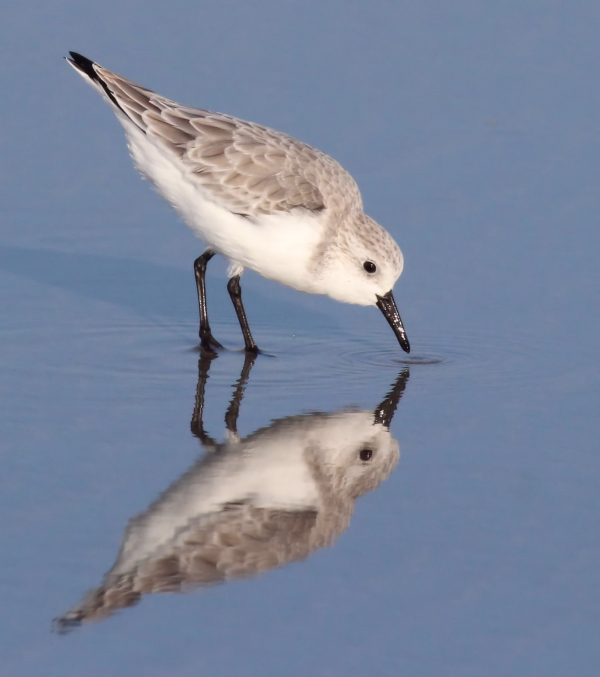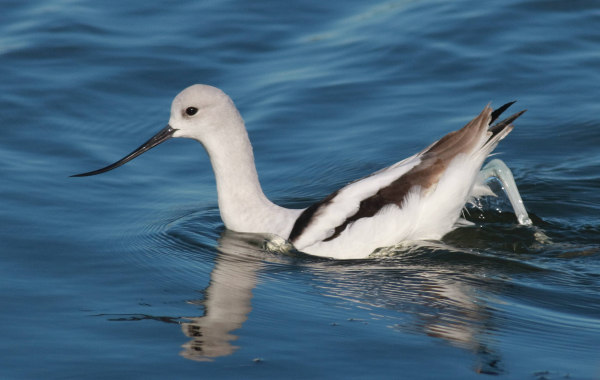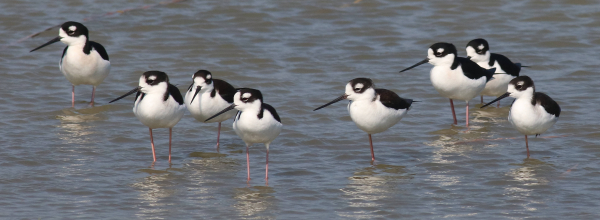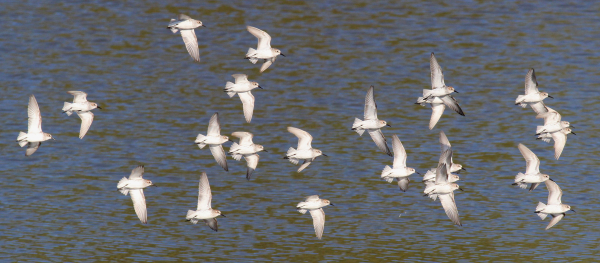Among my favorite winter photo subjects are the shorebirds – sandpipers, plovers, avocets, stilts, willets, godwits, curlews, yellowlegs, and the like – the shorebirds. Of course, shorebirds are rarely found where water freezes, so during winter, southern states from California to Florida tend to provide the best photo opportunities with a variety of shorebirds to be found, as well as varied social groups that may number in the tens, the hundreds – even in the thousands if you travel to a prime feeding and roosting area.
Shorebirds provide a variety of photo ops, by the diversity of their sizes, shapes, and colors; their numbers, and their activities as they search for food along wetland shores and ocean beaches. Walking, wading, probing, flying, competing, bathing, resting, roosting – singularly, in varied flocks, often species-specific, often sharing feeding sites with a variety of species. In short, shorebirds provide a variety of photo options and opportunities, especially during winter when they tend to be more social and more concentrated at suitable shallows, beaches, and mud flats.

Photo Specifics
Since you probably don’t have shorebirds in your yard, plan to visit a shorebird hangout while the sun is shining, preferably during mid-afternoon or mid-morning when the sun is at the best angle for photography during winter. Good sunlight is imperative to getting good bird photographs, so it’s best to dismiss photographing during cloudy weather. Just as important is to time your photo session when the sun will be at your back at the location you have in mind. I often say timing is everything, but lighting is just as important, and the direction of the sunlight is paramount to getting the best photos possible – keep the sun at your back and check your shadow to ensure it points at the birds before you.

American Avocets are a favorite shorebird subject for many bird photographers, so it’s always a delight to get a “different” image, like this swimming avocet in basic winter plumage.
|
A zoom lens is most versatile when photographing shorebirds, but a telephoto is almost equally useful. Usually you get your best photos from a distance, which puts shorebirds at ease to act naturally, and to realize that even though you may be standing tall and large, you are no danger to them – which may bring them closer eventually.
While you are photographing, work on trying not to center birds in your photo frame. Position the bird to one side of the frame or the other, providing a little extra space in front of the bird for it to look into, walk into, or fly into. Artists and designers often use the “law of thirds,” pointing out that the points to the right and left of center are more powerful positions for subjects.
I preset my camera using the aperture-priority (Av) mode setting on my Canon camera, and adjust the aperture to f8 to begin with. Using the f-stop, the camera automatically calculates the shutter speed with regard to the available light, which is likely more than 1/1000 of a second – usually ample shutter speed to stop motion including most shorebird flights, and the f8 aperture usually provides an ample area in focus for a single shorebird, and often for a small group depending on their positioning. Of course, you can always change your settings when there is a break in the action or as opportunity permits, so you can increase the area of focus to f11 or f14, for example, so a flock of birds are in focus.

Shorebirds on Foot
Photographing shorebirds is a lot of fun, and one of the most enjoyable aspects of photographing wintering shorebirds is the opportunity to walk along the edge of the shoreline, possibly even along the shore of a lake or an ocean beach. It’s still important to walk without displacing foraging or resting birds of course, but you can even kick off your shoes and feel the sand between your toes as you approach sandpipers and watch for flights of plovers. Photographing shorebirds is incentive enough to get outdoors, but to get some exercise and fresh air in the process is tough to beat.
Often while walking, our photos are taken while we stand, looking down at the birds along the water’s edge. You can always change that angle by kneeling down to get closer to the birds’ level. Then too, when you are in a lower position, you become less obvious and less ominous to wary birds that only stand inches above ground level. Watch for opportunities to take photos of shorebirds probing the sand or mud for foods, or when a bird runs along the water’s edge to reposition. Be aware of what birds are doing ahead of you, as well as behind you. You never know when a different species might fly in, or when a flock of avocets moves closer to the shoreline from deeper water. You may even get a rare photo of an avocet swimming, although keep in mind that avocets have webbed feet, so unlike most shorebirds, they are “equipped” for a swim when necessary.
As you are photographing, always be aware of the background. Often you will have a calm water setting, a wavy water background, or a sand or wet mud setting. Be aware of the colors, reflected light, vegetation, and other elements, and be prepared to take a step to the right or left, or several steps, if it improves the position of a bird or birds relative to their background. Also try standing tall, bending down, kneeling, and even sitting on the ground to get different background perspectives – so what if you get a little wet or dirty. Be creative, and consider a level of artistry as you photograph.

Fhotographing Flocks
When photographing a flock of birds, be sure to focus on birds closest to you. Too often, we focus in the middle of a flock, which can leave the birds in the front of the photo out of focus. By focusing on the front of the flock, the most obvious birds are in focus, and hopefully most others. If birds are out of focus, they will be birds at the back of the flock, which provides a much more acceptable image. Then, you can also adjust your aperture to an f14 or f17 to get more of the flock in focus – you get the idea.
If you have a small flock in focus, you be lucky enough to have them lined up within the same area of focus. Also keep in mind that it might be best to photograph a few birds at one end of a larger flock rather than trying to fit as many birds as possible in a given photo. But you may be able to do all of these things if you have the time to do some optional compositions of shorebirds before you. Flocks of shorebirds can be especially fickle, taking flight without apparent reason, so be prepared for such opportunities. However, when shorebirds take flight be sure to look up to see if a Peregrine, Prairie Falcon, or Merlin is in the area.

Flight Fotos
When flocks of feeding or resting shorebirds take flight en masse, they will often return to the same resting or feeding location, so it may provide a good opportunity to photograph birds as they approach and land. These can be especially good photo opportunities, often characterized by a series of birds landing over a minute or two. Also watch for a flying flock of sandpipers to switch sides by turning their bodies simultaneously from side to side, uniformly showing their underside, then their topside (ventral and dorsal sides).
My favorite way of photographing flying shorebirds is to find a location where they are regularly passing by, flying from one location to another, flock after flock and individually. That’s when I get positioned with the sun at my back and wait for the birds to come to me, trying to take a classic photo or 2 as different species pass by.
To be ready for any action situation, especially flight photography, I always set my camera’s Drive Mode for “Continuous Shooting.” In continuous shooting mode, the camera takes photos as long as you hold the shutter button down – up to 5 photos per second with my camera; up to 10 frames per second with higher-end models. I tend to take 2 photos at a time of flying birds, but when the opportunity arises, it’s worth taking a series of photos over a few seconds. The resulting series of photos provides you with a variety of photos from which you can select your favorite images – with wings up, wings down, gliding, banking, diving – enjoy giving it a try when you can.
The other important technical consideration for flight photos is your camera’s autofocus, which works best when a flying bird is fairly close. Sometimes, if you are not locking on to a flying bird as it passes, it may require you to press your shutter button halfway a second time to get the autofocus to lock in and track the bird as its flight progresses.
Although the following aspect of flight photography is rarely addressed, keep in mind that it is often hard to keep a flying bird within a camera’s photo frame. It’s not easy to follow the often rapid and sometimes erratic flight of a bird. I often get a little riled when I’m trying to follow and photograph flying birds and am a bit disappointed when I see resulting photos with part of the bird outside a photo frame; but that’s often part of the mix when taking photos of any birds in flight. Do your best, keep repeating the action, and you will get better; but I doubt anyone doesn’t have this problem at times – it’s just part of the process, an exciting part of flight photography!
Shorebirds offer birders with exceptional photo opportunities year-round, but winter photo options can be especially fulfilling. If you are lucky enough to have wintering shorebirds near home or work, make it a point to enjoy the varied photo means and methods, and try a new camera setting or two along the way. It will make you a better photographer, and a better birder overall. But most of all enjoy the shorebirds, and the great outdoors that shorebirds lead you to experience.
Article and photos by Paul Konrad
Share your bird photographs and birding experiences at editorstbw2@gmail.com
